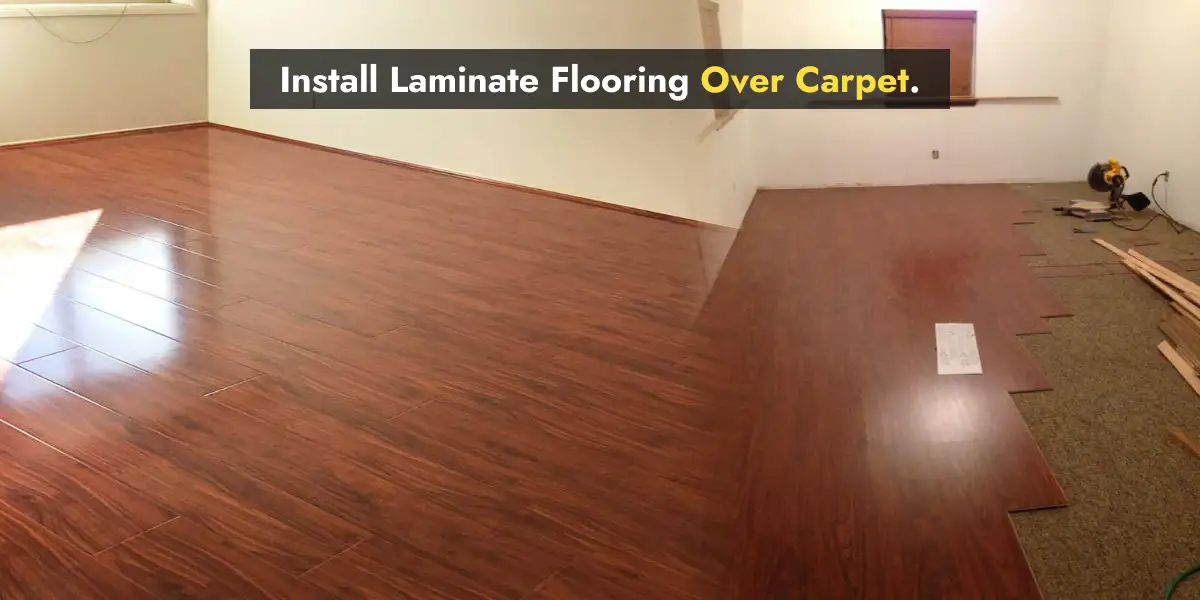Are you planning to install laminate flooring for your home?
Let me tell you laminate is a great choice for many reasons – it’s durable, low-maintenance, affordable, and comes in various styles and colors.
Besides, it is easy to install and clean. Laminate flooring can be used on different surfaces like carpet, wood, and tile.
But, you have carpet previously installed and you are thinking of installing laminate over it. The question that must be popping into your mind is: Can you Install Laminate Flooring Over the Carpet?
Yes, it is possible, but it is not recommended. Because carpet is not a stable surface. And laminate flooring requires a stable surface to be installed on. This combination can lead to laminate issues like warping or buckling.
But, if you want your laminate to last for years, you’ll need to remove the carpet. Then, prepare the subfloor, and install it correctly.
In this article, we’ll walk you through how to install laminate flooring over carpet safely.
Problems When You Install Laminate Flooring Over the Carpet
Installing laminate flooring over carpet can lead to several problems:
- Uneven Surface: The soft and plush nature of the carpet can result in an uneven surface, causing the laminate planks to not lay flat or lock properly.
- Reduced Stability: The carpet lacks the stability required for laminate flooring. This instability can cause the laminate to shift, buckle, or warp over time.
- Moisture Retention: Carpet can trap moisture, leading to issues like mold, mildew, or rot beneath the laminate flooring.
- Decreased Durability: Laminate flooring over carpet may experience premature wear and tear due to the lack of a solid foundation, resulting in a shorter lifespan.
- Voided Warranty: Installing laminate flooring over carpet typically voids the warranty provided by the manufacturer, leaving you unprotected in case of issues.
It’s strongly advised to remove the carpet before installing laminate flooring to ensure a stable, long-lasting, and visually appealing result.
Step-by-Step Guide to Install Laminate Flooring Over Carpet
Installing laminate flooring over carpet is generally not recommended due to various issues it can cause. Yet, if you still want to proceed, here’s a step-by-step guide:
Step 1: Supplies Needed
- Measuring tape
- Utility knife
- Pry bar
- Hammer
- Spacers
- Adhesive tape (for seams, if required)
- Carpenter Square
- Underlayment
- Laminate flooring
- Pull bar
- Tapping bar
- Rubber mallet
- Clamps
- Compass
Step 2: Assessing the Carpeted Area
It is important to assess the carpeted area before installing laminate flooring.
You should first test your carpet, whether it is low-pile or high-pile. Secondly, carpet thickness and texture determine how durable your laminate will be.
Next, assess the condition of your carpet. Are there any tears or signs of wear? Before installing laminate flooring, consider whether your carpet needs repairs or even replacement.
Then, inspect for moisture, mold, mildew, or discoloration in both the carpets and the subfloor. Make sure the subfloor is in good shape – no major cracks, and it should be nice and level.
Step 3: Acclimate the Laminate Flooring
Give your laminate about 48 hours to settle in the room where it’ll be installed.
Keep those planks lying flat. By doing this, you can reduce the chances that the floor will not contract or expand after installation
It is important to acclimatize your laminate floor to ensure it behaves and lasts.
Step 4: Install Underlayment
Lay down a moisture barrier underlayment over the carpet. This layer helps prevent moisture from seeping up through the carpet.
And affects the laminate flooring, which is particularly important in areas prone to moisture.
Don’t forget to apply adhesive tape to the seams for thorough coverage.
Following the instructions on your laminate floor will increase its longevity and quality. And it gives your planks a nice, even finish.
Step 5: Trim Door Jambs and Moldings
Trim the bottom of door jambs to allow space for the laminate flooring to slide underneath. Also, remove any baseboards or moldings along the walls to accommodate the height of the laminate flooring once it’s installed.
Step 6: Start Installation
Install the planks along the walls by placing spacers. It creates a gap that will allow your floor to expand and contract without causing problems.
Next, join those grooved edges of the planks together. It’s like piecing together a puzzle, and when you’re done, secure it with an installation kit.
Keep spacing the planks evenly as you go. By doing this, your floor will look balanced and natural. It’s all about making it fit like a glove!
Step 7: Install First Row
Make sure you have a good, level gap between the first row of planks and the longest wall. It gives your floor room to breathe.
Now, line up those tongue and groove edges perfectly as you lay down the planks. When they fit tightly, click them firmly together.
For extra stability, use an installation kit. It comes with handy tools like tapping blocks and tension bars. These help you build a rock-solid foundation for the rows of planks to come.
Step 8: Install Transition Strips
When you move from one room to another, your laminate may meet different kinds of floors. It helps to create a smooth, polished appearance with transition strips.
Make sure the strip fits snugly in its place. It depends on the type of strip whether you secure it with adhesive or screws.
Additionally, it keeps things safe, especially when moving from one surface to another.
Step 9: Finishing Touches
After you’ve got your laminate flooring in place, don’t forget to take out those wall spacers. They served their purpose, and now they can go.
Installing baseboards or quarter-round moldings on your new floor can add a polished look. You will be able to cover up those expansion gaps and everything will look neat. You’ve reached the pinnacle of laminate flooring.
Pros & Cons of Installing Laminate Over Carpet
Pros
- Cost Savings: You can save on the cost of removing and disposing of the carpet. As well as potential subfloor preparation expenses.
- Quick Installation: It may be faster to install laminate over the carpet. Compared to removing the carpet and preparing the subfloor. Especially if the carpet is in good condition.
- Temporary Solution: It can serve as a temporary flooring solution. Especially in rental properties, where permanent changes may not be allowed or desired.
Cons
- Instability: The carpet lacks the stability needed for laminate flooring. Leading to potential movement, buckling, or warping of the laminate planks over time.
- Uneven Surface: The soft and plush nature of the carpet can result in an uneven surface. Causing the laminate flooring to be uneven and not lay flat.
- Moisture Retention: Carpet can trap moisture. Leading to issues like mold, mildew, or rot beneath the laminate flooring. Especially in humid environments.
- Voided Warranties: Installing laminate flooring over carpet typically voids the manufacturer’s warranty. Leaving you unprotected in case of issues.
- Aesthetic Concerns: The texture and thickness of the carpet may show through the laminate flooring. Affecting its appearance and overall aesthetic.
FAQs: Can You Install Laminate Flooring Over the Carpet?
How do I know if my carpet is suitable for laminate installation?
To determine if your carpet is suitable for laminate installation, assess its condition and thickness.
The carpet should be in good condition without tears, stains, or excessive wear.
Additionally, consider the carpet’s thickness. Thicker carpets may create an uneven surface and compromise the stability of the laminate flooring.
If the carpet is thin and in good condition. You may be able to install laminate flooring over it with proper preparation.
Yet, for optimal results, it’s generally recommended to remove the carpet. And install laminate flooring on a clean, flat subfloor.
Can I install laminate over commercial-grade carpet?
Installing laminate over commercial-grade carpet is generally not recommended.
Commercial-grade carpet is often thicker and denser. Which can cause these problems and compromise the integrity of the laminate flooring.
It’s best to remove the commercial-grade carpet and install laminate flooring on a clean, flat subfloor. This approach ensures a stable foundation. And minimizes the risk of issues such as movement, buckling, or voided warranties.
Check Out More Articles Related to Floorings:
- Can You Put Vinyl Flooring Over the Carpet? (9 Easy Steps)
- How to Clean Old Hardwood Floors After Removing Carpet? (5 Easy Steps)
- 7 Best Ways to Remove Gorilla Glue from Carpet (Includes Natural Ways)
- 5 Best Ways to Fix Discolored Laminate Floor Under Rug (Must-Read!)





